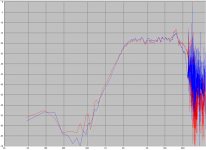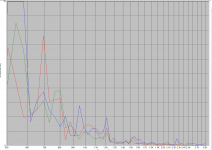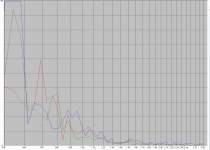Well "good" is definitely a relative term. "Good" against what? A "good" Toyota does not really say much.
Sorry, I have no idea what that's supposed to mean. A few minutes searching of the afore mentioned forums should easily turn up comments about that tweeter. Some people love it and some people don't, and those that don't report similarly to the OP. Interestingly one of the posts on HTguide does mention possible change in the tweeter build <2008. At any rate, there is plenty of info out there going back 10yrs+.
Just one example:
- CJD, Htguide.Jim and I like to go around on the tweeter discussion - we agree on the sonic traits largely, but we disagree on our choice(s) of the bunch. I find the TBFC to be sweet, but fatigue inducing - a tad harsh.
Just one example:
- CJD, Htguide.
A plural of an anecdote is not data and definitely not "true".
A plural of an anecdote is not data and definitely not "true".
Lol, you're really wanting to make this into something more than it is, choosing to parse words with me vs. looking up the information yourself. Have fun with that.
Lol, you're really wanting to make this into something more than it is, choosing to parse words with me vs. looking up the information yourself. Have fun with that.
I think it's you that are having fun.
I'm really interested to see what the measurements say... and will post these up.
If I can't see the difference in measurements, either:
1. My measurements are flawed
2. I'm measuring the wrong thing to show the differences in the tweeters or
3. Not all that can be heard can be measured (ie. we lack a measurement, or my ears / brain are not able to be assessed, except via a can opener, which I'm not willing to undergo quite at this stage of design).
If I can't see the difference in measurements, either:
1. My measurements are flawed
2. I'm measuring the wrong thing to show the differences in the tweeters or
3. Not all that can be heard can be measured (ie. we lack a measurement, or my ears / brain are not able to be assessed, except via a can opener, which I'm not willing to undergo quite at this stage of design).
The way the off axis plays, if different enough, can influence the sound in ways that some people do not find pleasant. I'd say that the metal tweeter has every so slightly more off axis energy than the fabric, due to its phase shield. You could try removing it and seeing what that does to the sound. That should, theoretically, give it worse off axis performance than the fabric version.
I'm really interested to see what the measurements say... and will post these up.
If I can't see the difference in measurements, either:
1. My measurements are flawed
2. I'm measuring the wrong thing to show the differences in the tweeters or
3. Not all that can be heard can be measured (ie. we lack a measurement, or my ears / brain are not able to be assessed, except via a can opener, which I'm not willing to undergo quite at this stage of design).
Well measurements are only 3% of speaker design. Here would be my takes:
building cabinet 70%
fine tune 100%
measurement 3%
As you can see, measurements don't count very much at all. Of course one has to know what to listen for in the fine tuning process. Without knowing how measurements correlate to sound, it is really fruitless. Personally once I do the initial measurements for the .frd and .zma files, I don't really bother to measure again until at the very end.
The way the off axis plays, if different enough, can influence the sound in ways that some people do not find pleasant. I'd say that the metal tweeter has every so slightly more off axis energy than the fabric, due to its phase shield. You could try removing it and seeing what that does to the sound. That should, theoretically, give it worse off axis performance than the fabric version.
Both have the hexagrid cover. I don't know if the D version has the acoustic lense in the centre. I'd need to check. PS: these were factory supplied hexagrid - ie /G versions. They have not been modified by me.
Everything remained the same - apart from swapping tweeters. I was ~ 10 degrees off axis (normal listening position) and my partner ~ 25 degrees off axis. We both were able to conclude which tweeter was better behaved on the same recordings after 10 minute listening sessions back and forth. The only changes were the tweeter swap. We then varied volume levels on both. the B never got better, the D never got worse.
Well measurements are only 3% of speaker design. Here would be my takes:
building cabinet 70%
fine tune 100%
measurement 3%
As you can see, measurements don't count very much at all. Of course one has to know what to listen for in the fine tuning process. Without knowing how measurements correlate to sound, it is really fruitless. Personally once I do the initial measurements for the .frd and .zma files, I don't really bother to measure again until at the very end.
I think measurements are very useful to show if you are wildly off or in the ball park. What's surprised me is how different sounding these 2 tweeters are and I don't know why given they share the same motor and hexagrid cover. by and large the dome material is lighter (hence more sensitive) and stiffer (hence ultrasonic breakup mode) on the B version.
We'll wait and see - but I will be happy to conclude that "not all that can be heard can be measured" if my linear and non-linear distortion measurements show hardly any variation.
I also haven't eliminated a defective tweeter yet.
Harmonic distortion measurements. I'm not confident in these. I was more interested in the relative differences. but I don't trust I have the levels / setup right at all.
First up is the B tweeter (with a 0.7v sine wave output). I couldn't go higher or was clipping on the soundcard input/output reference loop. Will investigate.
First up is the B tweeter (with a 0.7v sine wave output). I couldn't go higher or was clipping on the soundcard input/output reference loop. Will investigate.
Attachments
I forgot to mention. Blue line = 2nd order, Red = 3rd order and green = 4th order HD.
If 3rd order is the most relevant for nastiness, then the B has a noticeable spike around 1200Hz. That was the only consistent one over 3 measurements (anything below about 1Khz was volatile).
If 3rd order is the most relevant for nastiness, then the B has a noticeable spike around 1200Hz. That was the only consistent one over 3 measurements (anything below about 1Khz was volatile).
And now for the measurements.... First up - the on-axis response with crossover in place. The blue = 27TBFC/G and red = 27TDFC/G. White was my LR4 target.
Give us 1dB grid, please and spread it 1-20KHz - showing from 20Hz-40KHz just collapses the grid.
Last edited:
And now for the measurements.... First up - the on-axis response with crossover in place. The blue = 27TBFC/G and red = 27TDFC/G. White was my LR4 target.
Interesting I didn't realise that SEAS made a version of the fabric dome with a hexagrid cover.
I don't think that it would contain the phase shield though because that's something that's reserved for the aluminium dome, as it, specifically, needs the off axis improvements.
I'm not sure what to think of your measurements though as that peak at around 16kHz shouldn't be there.
As to the distortion measurements, the fabric dome has the smoother distortion profile. Where the distortion peaks up for the metal dome though is well below the tweeters passband and where the signal to noise ratio is falling. Given the drive level neither tweeter should be displaying peaks/spikes and these could just be measurement artefacts. Did you repeat the distortion measurements to confirm that the spikes at 1.2kHz were really there?
Interesting I didn't realise that SEAS made a version of the fabric dome with a hexagrid cover.
I don't think that it would contain the phase shield though because that's something that's reserved for the aluminium dome, as it, specifically, needs the off axis improvements.
I'm not sure what to think of your measurements though as that peak at around 16kHz shouldn't be there.
As to the distortion measurements, the fabric dome has the smoother distortion profile. Where the distortion peaks up for the metal dome though is well below the tweeters passband and where the signal to noise ratio is falling. Given the drive level neither tweeter should be displaying peaks/spikes and these could just be measurement artefacts. Did you repeat the distortion measurements to confirm that the spikes at 1.2kHz were really there?
I bought the hexagrid D at madisound. Can't remember when (need to maybe look at tweeter datestamp). I never saw it listed on the SEas website either. Maybe I have a collectable
The 16KHz peak is due to my poor calibration I think. I'd ignore it but I think as the artefact appears on both measurements, it shows consistency and if that was a real peak and manifested itself, my little listening dislike would appear with both drivers.
The harmonic distortion measurements are not consistent with the 3 indoor runs I've done (again gated). I really don't know what I am doing in the non-linear measurement department. So I fully expect my measurements could be crap allowing no meaningful interpretation. They were taken using speaker workshop using the 1 power vs frequency, with 80 samples between I think 500Hz and 3KHz (as I don't believe my problem is higher in frequency...., and lower in frequency shows distortion I just don't think is there!) meaning suspect measurements.
How can I "profile" a song to identify the problematic frequencies causing my ears to bleed?
Last edited:
Give us 1dB grid, please and spread it 1-20KHz - showing from 20Hz-40KHz just collapses the grid.
I can do- but I don't think this will show anything meaningful. Was there a part of the spectrum your wanted to zoom in on?
PS: I posted the full measurement, incase any of the 20KHz+ junk had any bearing. The full measurement so to speak. I realise it could be limitations of my measurement system, but thought it best for others to decide rather than filter out data.
How can I "profile" a song to identify the problematic frequencies causing my ears to bleed?[/QUOTE]
What I usually try to do is play it back through software that has a graphic equalizer and play with the different frequencies until the offending area stands out.
Also I do measurements from the listening position to see if there is any area of the response that reveals itself as problematic off axis.
What I usually try to do is play it back through software that has a graphic equalizer and play with the different frequencies until the offending area stands out.
Also I do measurements from the listening position to see if there is any area of the response that reveals itself as problematic off axis.
What I usually try to do is play it back through software that has a graphic equalizer and play with the different frequencies until the offending area stands out.
Also I do measurements from the listening position to see if there is any area of the response that reveals itself as problematic off axis.
thanks. I should have thought of that. Great suggestion.
I'm playing through a PC, so I can use a software graphic equaliser to isolate.
I'll also take 2 listening position measurements, ungated to see what stands out.
Last edited:
- Status
- This old topic is closed. If you want to reopen this topic, contact a moderator using the "Report Post" button.
- Home
- Loudspeakers
- Multi-Way
- Seas 27TBFC/G vs 27TDFC/G


